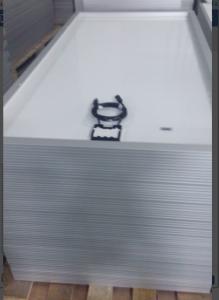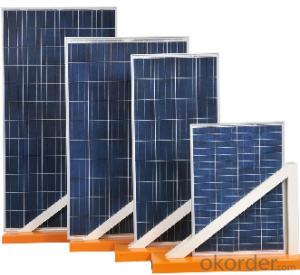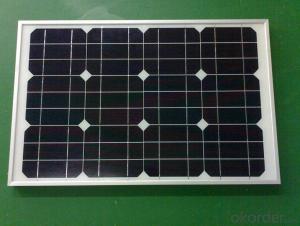Engie Solar Panels - PV Solar Module, High Efficiency A/B Grade 156*156/125*125 Solar Cell
- Loading Port:
- China main port
- Payment Terms:
- TT OR LC
- Min Order Qty:
- 1 pc
- Supply Capability:
- 10000000 pc/month
OKorder Service Pledge
OKorder Financial Service
You Might Also Like
Quick Details
| Place of Origin: | Guangdong China (Mainland) | Brand Name: | Felicitysolar | Model Number: | FLS-M-300W |
| Material: | Monocrystalline Silicon | Size: | 1954*992*40mm | Max. Power: | 300w |
| weight: | 25kg | Warranty: | 5 years | Current max power: | 8.33A |
| Voltage max power: | 36.0V | Short cicuit current: | 9.58A | Open circit voltage: | 41.6V |
| Temperature range: | -40℃ -- +85℃ | OEM: | avaliable |
Packaging & Delivery
| Packaging Detail: | 2 pcs/ piece |
| Delivery Detail: | Whitin 18 days after recevie the deposit. |
Specifications
monocrystalline solar module
1.High efficiency,energy saving,use safe.
2.Easy handle,high quality,low price,good after service
Solar Module
SPECIFICATION |
Model No.:FL-P250 | |
Max.Power(±5%)[Pmax] | 300Wp |
Current Max.Power[lmp] | 8.33A |
Voltage Max.Power[Vmp] | 36.0V |
Short Circuit Current[Isc] | 9.58A |
Open Circuit Voltage[Voc] | 41.6V |
Max.System Voltage | 1000VDC |
Cell Technology | Polycrystalline |
Module dimension | 1954x992x40mm |
Weight | 25.0Kg |
All technical data at standard test condition:AM=1.5, E=1000W/m2℃
Produced in correspondence with international safety standards.
WARNING:HAZARDOUS ELECTRICITY!
CAN SHOCK,BURN OR CAUSE DEATH. Do not touch terminals
PRODUCT DISPLAY |
PRODUCT STRUCTURE |
1. glass
Its main role is to protect the power generation ( solar cells ) , there is a selection of light transmittance requirements : 1 ) must be high transmittance (typically 91% or more ) ; 2 ) super white steel processing.
2. EVA
For bonding glass and power generation fixed body ( such as cells ) , transparent EVA material directly affect the life of components exposed to the air EVA prone aging yellow , thus affecting the transmittance components , thus affecting in addition to generating the quality of the components itself, the quality EVA lamination process on the component manufacturers is also very large, such as EVA plastic viscosity of non-compliance , EVA and glass, back bonding strength is not enough, can cause premature aging EVA, the affected component life.
3. Solar cells
The main role is to generate electricity , the electricity is the main market mainstream film crystalline silicon solar cells , thin-film solar cells , both have their advantages and disadvantages . Crystalline silicon solar cells , the equipment costs are relatively low , but the high cost of consumption and cells , photoelectric conversion efficiency is high, the next generation in outdoor sunlight is more appropriate ; higher thin-film solar cells , the relative cost of equipment , but the cost of consumption and battery low, relatively low photoelectric conversion efficiency of crystalline silicon solar cells , but the effect is very good low-light , in the ordinary light can also generate electricity , such as solar calculator .
4. backplane
Sealing, insulation , water ( usually with TPT, TPE , etc. ) the material must be resistant to aging , component manufacturers generally have warranty for 25 years , tempered glass, aluminum is generally no problem , the key lies in whether the backplane and can meet the requirements of silica gel.
WORKING PRINCIPLE |
Solar panels solar power system is the core part of the solar system, the highest part of the value . Its role is to convert solar energy into electrical energy stored in batteries or sent to , or promote the work load .
When the p -type semiconductor and n -type semiconductor when combined together into a tight , at the interface between the p-n junction is formed . When the cell is irradiated with sun light in the p-n junction is formed on both sides of the positive and negative charge accumulation , the photovoltaic generation of the formation of the internal electric field , which is " photovoltaic effect ." Theoretically, this time, if the electric field on both sides of the built-in and lead-out electrodes connected to an appropriate load , the current will be formed , will be obtained on the load power . The solar cell module is the use of electronics to achieve characteristics of the semiconductor material of solid P-V conversion means . Which is the photovoltaic solar battery works .
PRODUCT ADVANTAGE |
Advantages
1.High power, high efficiency
2. Long lifespan, energy saving, environmental-friendly
3. Advanced technology, exquisite workmanship
4. Easy installation, free maintenance
FAQ |
[Q:] what is the solar module? [A:] solar panels by cells, components of the border, toughened glass, packaging materials and the junction box and so on, a piece of board can use sunlight to power generation.
[Q:] what is the solar cell (plate)? [A:] solar cell (plate) is a use of solar power photoelectric semiconductor wafer.
[Q:] types of solar panels? [A:] Solar panel common mainly single crystal, polycrystalline,amorphous three materials. Among them, the best single crystal,high efficiency, the price is high; polycrystalline low efficiency of 2%,the price almost, this two kinds of life for more than 25 years;amorphous low efficiency, short life, but the price is cheaper. From the cost point of view, the highest or single crystal.
[Q:] Standard test conditions of solar cells [A:] Power solar panels is in standard condition: temperature of 25 degrees, AM1.5, 1000W/M2 under test. General use WP (WP) said,you can also use the W (W) said. Power test in this standard is called the nominal power.
[Q:] solar panel is how to work? [A:] solar panels can produce current in a certain intensity ofillumination, the electrical appliance can be used. The premise is the unit of current time than electrical consumption. In practical application, the direct use of the situation is less. Generally the whole system to use.
- Q: Can solar panels be used in areas with high levels of rainfall?
- Yes, solar panels can be used in areas with high levels of rainfall. While rainfall may temporarily reduce the amount of sunlight reaching the panels, modern solar panels are designed to efficiently capture and convert even diffuse light. Additionally, regular rainfall can help keep the panels clean, improving their overall performance.
- Q: Online stores selling solar photo-voltaic generation kits gives specs indicating the power generation capability of the system. For example, Solar World Grid-Tie Solar Electric System with 245W Panels PV Powered PVP2000 Inverter, .2 to 2.4 kW. This seems to indicate that the system can generate .2 to 2.4 kW. Is that per day? Per month? I'm trying to calculate the return on investment, but can't because I don't know how much power a system such as this will generate in a month.
- There okorder From panels, to inverters, to controllers, etc. Just look in their alternative energy section. If you happen to have aboutt 30,000 dollars to drop on the installation and you plan to live their more than 0 years, talk to your power company and they can set you up completely.
- Q: How do solar panels impact the electric bill?
- Solar panels can significantly reduce or even eliminate electric bills by generating electricity from the sun. By harnessing solar energy, homeowners can offset their electricity consumption with clean and renewable energy, therefore reducing their reliance on the grid and the associated costs. Additionally, excess energy produced by solar panels can be stored in batteries or fed back into the grid, allowing homeowners to earn credits or compensation for the surplus electricity they generate.
- Q: Can solar panels be used in areas with high levels of seismic vibrations?
- Yes, solar panels can be used in areas with high levels of seismic vibrations. However, it is important to ensure that the solar panel installation is structurally sound and designed to withstand the vibrations caused by seismic activities. Additional measures such as reinforced mounting systems or flexible support structures may be needed to enhance the resilience of the solar panels in such areas.
- Q: my pool guy cleaned the filter and replaced the DE, but now my roof solar panels have started leaking. how do i stop the leak? does backwashing help in any way?
- If you do not isolate the solar system when backwashing your filter, you WILL pump DE into the panels and plug them and destroy them. At this point you may have to disconnect the panels, wash them from the RETURN SIDE (from the higher pipe and HOPE that the DE will flow out of the panels... most likely your pool guy just screwed up your solar real good... if the DE is plugging your panels, when winter comes your panels will split because they are holding water and the freezing water will split them... I hope your pool guy has insurance
- Q: I really want a projector but i hear they use a lot of energy because of the lamp. I want a good one to watch movies and play games on. but i don't want one that is gonna kill the lighting bill.is there like a solar panel or something i could use for it. PLZ HELP.
- Do understand, that a solar panel is slow to pay for itself. Let's say your electric bill was $200 a month ($2400 a year). A solar system would cost perhaps $24,000 so you would actually have paid your first 0 years of electricity in advance when installing the panels. After that 0 years, you start to be ahead financially. It can still be a good idea, but it may not be the quick and cheap solution you were looking for.
- Q: Do solar panels require a specific type of wiring or electrical setup?
- Yes, solar panels typically require a specific type of wiring and electrical setup. They need to be connected to an inverter, which converts the direct current (DC) generated by the panels into alternating current (AC) that can be used in homes or fed back into the grid. Additionally, solar panels usually require specific wiring configurations to ensure proper grounding, protection against overcurrent, and compliance with local electrical codes and regulations.
- Q: I am looking to wire in some solar panels into my home. I already have plenty of wiring, and some solar panels around. I just need to know what I need to do to wire them into my home so I can lower my electric bill. This past month it was six hundred dollars.Can someone direct me to some information, or tell me how without telling me to hire some guy to come out to charge me thirty thousand dollars to install two or three thousand dollars worth of equipment?
- You okorder / If you are planing to build an off grid system or a grid tie system, it should be wired by an electrician. At the lest by someone that knows what they are doing. If it is a grid tie system you will need the local building inspector to sign the paper work before the public utility will allow you to hook in. To get the inspector to sign off you have to get a permit which requires a lic. electrician.
- Q: Are solar panels noisy?
- No, solar panels are not noisy. They do not have any moving parts and therefore, do not produce any noise while generating electricity from the sun.
- Q: Can solar panels be installed on a tennis court or sports complex?
- Yes, solar panels can be installed on a tennis court or sports complex. The large open spaces and flat rooftops typically found in these areas make them suitable for solar panel installation. This can help generate clean and renewable energy while also reducing the electricity costs of the facility.
Send your message to us
Engie Solar Panels - PV Solar Module, High Efficiency A/B Grade 156*156/125*125 Solar Cell
- Loading Port:
- China main port
- Payment Terms:
- TT OR LC
- Min Order Qty:
- 1 pc
- Supply Capability:
- 10000000 pc/month
OKorder Service Pledge
OKorder Financial Service
Similar products
Hot products
Hot Searches
Related keywords


























